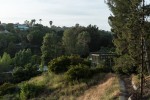Sage Hill is located off Bellagio Drive by the Krieger Center. The four-acre space is covered with rolling hills of small native shrubs, such as the coastal sage scrub and California sagebrush, which are dotted with flowers in the springtime. Laurel sumac, a species of small tree, rises above the other shrubs, providing light shade at the site. Visitors can spot some native fauna too – desert cottontail rabbits and the dusky-footed wood rats wander about the area, residing among the twigs and shrubs.
But most students will never see it.
The campus’ urban surroundings and non-native flora block views of the chaparral biome surrounding UCLA. But even if students want to see it for themselves, they can’t: Sage Hill is only open to faculty conducting research about the site and certain classes for field trips, according to Nurit Katz, UCLA’s chief sustainability officer.
Katz said the site is not open to the general public because additional visitors would interfere with restoration efforts, such as cleanup efforts and getting rid of invasive species.
Sage Hill should be open to all UCLA students, not just the few who are in the geography, biology or geology classes that visit the site. By opening the area to all UCLA students and installing formal management, UCLA can help students learn about and appreciate the last natural habitat on campus.
Sage Hill is currently unmarked, making it easy for students to trespass without awareness of its ecological value. Although geography professor Thomas Gillespie said the site could handle more visitors, lack of clear labeling at the entrance and throughout the property exacerbates environmental damage: Students often smoke at Sage Hill or leave trash there. The Sage Hill task force to preserve the area, the task force could do a lot more to make it accessible to more students and Facilities Management could help handle the extra traffic.
Facilities Management would need to install signs at the entrance informing visitors of rules for the site, such as the hours it is open. The entry sign should also address possible pitfalls for the environment by telling visitors to stay on the trails, to pick up trash and to not smoke on the premises. Signs should also clearly mark the direction of the trail throughout the site so visitors don’t step off the trail and harm the natural wildlife.
Such signs at the entrance and throughout the site should also educate visitors about the types of plants at Sage Hill and the task forces’ restoration efforts. Sage Hill boasts over 50 native chaparral flora, seven native mammal species, around 17 species of butterflies and almost 30 bird species, making it a highly biodiverse area. Without proper labels, most visitors won’t notice the wide array of flora and fauna at the site. Proper signage would also make it easier for students to conduct research on the wildlife at Sage Hill, which is currently difficult without the guidance of a chaparral expert.
All of these improvements would make Sage Hill more like the Mildred E. Mathias Botanical Gardens, located at the southeast end of UCLA’s campus. Many students go to the botanical gardens to study or enjoy nature. The clear signage and well-marked trails make the botanical gardens accessible and educational for many visitors, while also helping to maintain the gardens. As a result, the botanical gardens can support many visitors, including faculty, students on field trips and people who just want to visit the gardens.
[Related: prime | More than a park]
The task force’s primary reason that Sage Hill cannot accommodate more students is it is in the middle of restoration efforts. But if that’s true, will Sage Hill ever be ready to handle more students? The task force has been undergoing restoration efforts for years.
Although the restoration efforts are not complete, Gillespie, who leads the initiative himself, said he thinks Sage Hill could be open to students so long as the site has clear signage to ensure students treat the area properly. Moreover, Gillespie said he takes field trip groups of around 200 students to Sage Hill all at once, so the site could certainly handle more student visitors.
In fact, opening Sage Hill up to more students and installing educational signs throughout the site would actually improve restoration efforts. If students are aware of Sage Hill’s environmental and historical significance and the value of the chaparral flora and fauna, they would more likely not litter the site or smoke there.
At a time when UCLA and Los Angeles are becoming ever more developed, UCLA’s last natural habitat should be more than a place for trespassing students to smoke weed: It should give all students the opportunity to appreciate the campus’ native flora and fauna.
